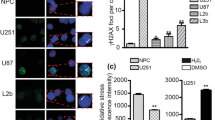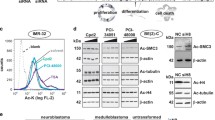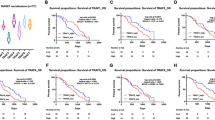Abstract
Purpose
Deletion or mutation of phosphatase and tensin homolog located on chromosome ten (PTEN) occurs in as high as 80% glioblastoma. All-trans retinoic acid (ATRA) induces differentiation in cancer cells. Interferon-gamma (IFN-γ) induces apoptosis in many cancers including glioblastoma. We used the combination of ATRA and IFN-γ to control growth of human glioblastoma LN18 (PTEN-proficient) and U87MG (PTEN-deficient) cells and explored any advantage of having PTEN in the cells.
Methods
LN18 and U87MG cells were treated with ATRA (1 μM) for 7 days and then IFN-γ (5 ng/ml) for 1 day. Methylene blue staining indicated astrocytic differentiation. Wright staining and ApopTag assay showed characteristic features of apoptosis. Western blotting demonstrated the levels of specific proteins.
Results
ATRA and IFN-γ alone and in combination could induce apoptosis in LN18 cells; while ATRA alone induced differentiation only, IFN-γ alone induced apoptosis, and ATRA plus IFN-γ increased apoptosis in U87MG cells. The variation in induction of apoptosis by ATRA alone might be attributed to difference in PTEN expression in the two cell lines. Compared with control cells, IFN-γ alone and ATRA plus IFN-γ increased PTEN expression in LN18 cells while there was no PTEN expression or induction in U87MG cells after treatments with ATRA alone and ATRA plus IFN-γ. Apoptosis in both cell lines was associated with increases in Bax:Bcl-2 ratio, mitochondrial release of cytochrome c into the cytosol, and calpain and caspase-3 activities. Treatments elevated p27kip1 and decreased CDK2 levels in both cell lines, indicating cell cycle arrest at G1/S phase.
Conclusions
The combination of ATRA and IFN-γ could control the growth of both PTEN-proficient and PTEN-deficient glioblastoma cells by arresting cell division and inducing differentiation and apoptosis. Thus, our study indicated that the growth of both PTEN-proficient and PTEN-deficient glioblastoma cells could effectively be controlled by treatment with the combination of ATRA and IFN-γ.







Similar content being viewed by others
References
Adachi J, Ohbayashi K, Suzuki T, Sasaki T (1999) Cell cycle arrest and astrocytic differentiation resulting from PTEN expression in glioma cells. J Neurosurg 91:822–830
Asou N (2007) All-trans retinoic acid in the treatment of acute promyelocytic leukemia. Intern Med 46:91–93
Brandts CH, Bilanges B, Hare G, McCormick F, Stokoe D (2005) Phosphorylation-independent stabilization of p27kip1 by the phosphoinositide-3-kinase pathway in glioblastoma cells. J Biol Chem 280:2012–2019
Das A, Banik NL, Patel SJ, Ray SK (2004) Dexamethasone protected human glioblastoma U87MG cells from temozolomide induced apoptosis by maintaining Bax:Bcl-2 ratio and preventing proteolytic activities. Mol Cancer 3(1):36
Das A, Banik NL, Ray SK (2006) Mechanism of apoptosis with the involvement of calpain and caspase cascades in human malignant neuroblastoma SH-SY5Y cells exposed to flavonoids. Int J Cancer 119:2575–2585
Eng C (2003) PTEN: one gene, many syndromes. Hum Mutat 22:183–198
Fax X, Aalto Y, Sanko SG, Knuutila S, Klatzmann D, Castresana JS (2002) Genetic profile, PTEN mutation and therapeutic role of PTEN in glioblastomas. Int J Oncol 21:1141–1150
Garzon R, Pichiorri F, Palumbo F, Visentini M, Aqueilan R, Cimmino A, Wang H, Sun H, Volinia S, Alder H, Calin GA, Liu CG, Andreeff M, Croce CM (2007) MicroRNA gene expression during retinoic acid-induced differentiation of human acute promyelocytic leukemia. Oncogene 29:1–10
Haque A, Das A, Hajiaghamohseni LM,Younger A, Banik NL (2007) Induction of apoptosis and immune response by all-trans retinoic acid plus interferon-gamma in human malignant glioblastoma T98G and U87MG cells. Cancer Immunol Immunother 56:615–625
Hwang PH, Yi HK, Kim DS, Nam SY, Kim JS, Lee DY (2001) Suppression of tumorigenicity and metastasis in B16F10 cells by PTEN/MMAC1/TEP1 gene. Cancer Lett 172:83–91
Jendrossek V, Belka C, Bamberg M (2003) Novel chemotherapeutic agents for the treatment of glioblastoma multiforme. Expert Opin Investig Drugs 12:1899–1924
Jonason JH, Gavrilova N, Wu M, Zhang H, Sun H (2007) Regulation of SCF (SKP2) ubiquitin E3 ligase assembly and p27kip1 proteolysis by the PTEN pathway and cyclin D1. Cell Cycle 6:951–961
Karmakar S, Banik NL, Patel SJ, Ray SK (2007) Garlic compounds induced calpain and intrinsic caspase cascade for apoptosis in human malignant neuroblastoma SH-SY5Y cells. Apoptosis 12:671–684
Kim JS, Lee C, Bonifant CL, Ressom H, Waldman T (2007) Activation of p53-dependent growth suppression in human cells by mutations in PTEN or PIK3CA. Mol Cell Biol 27:662–677
Kleihues P, Louis DN, Scheithauer BW, Rorke LB, Reifenberger G, Burger PC, Cavenee WK (2002) The WHO classification of tumors of the nervous system. J Neuropathol Exp Neurol 61:215–225
Lee YR, Yu HN, Noh EM, Kim JS, Song EK, Han MK, Kim BS, Lee SH, Park J (2007) Peroxisome proliferator-activated receptor gamma and retinoic acid receptor synergistically upregulate the tumor suppressor PTEN in human promyeloid leukemia cells. Int J Hematol 85:231–237
Li J, Yen C, Liaw D, Podsypanina K, Bose S, Wang SI, Puc J, Miliaresis C, Rodgers L, McCombie R, Bigner SH, Giovanella BC, Ittmann M, Tycko B, Hibshoosh H, Wigler MH, Parsons R (1997) PTEN, a putative protein tyrosine phosphatase gene mutated in human brain, breast, and prostate cancer. Science 275:1943–1947
Nath R, Raser KJ, Stafford D, Hajimohammadreza I, Posner A, Allen H, Talanian RV, Yuen P, Gilbertsen RB, Wang KK (1996) Non-erythroid α-spectrin breakdown by calpain and interleukin-1β-converting-enzyme-like protease(s) in apoptotic cells: contributory roles of both protease families in neuronal apoptosis. Biochem J 319:683–690
Parney IF, Chang SM (2003) Current chemotherapy for glioblastoma. Cancer J 9:149–156
Pasquali D, Chieffi P, Deery WJ, Nicoletti G, Bellastella A, Sinisi AA (2005) Differential effects of all-trans retinoic acid (RA) on Erk1/2 phosphorylation and cAMP accumulation in normal and malignant human prostate epithelial cells: Erk1/2 inhibition restores RA-induced decrease of cell growth in malignant prostate cells. Eur J Endocrinol 152:663–669
Pique M, Barragan M, Dalmau M, Bellosillo B, Pons G, Gil J (2000) Aspirin induces apoptosis through mitochondrial cytochrome c release. FEBS Lett 480:193–196
Ray SK, Wilford GG, Crosby CV, Hogan EL, Banik NL (1999) Diverse stimuli induce calpain overexpression and apoptosis in C6 glioma cells. Brain Res 829:18–27
Shingu T, Yamada K, Hara N, Moritake K, Osago H, Terashima M, Uemura T, Yamasaki T, Tsuchiya M (2003) Growth inhibition of human malignant glioma cells induced by the PI3K-specific inhibitor. J Neurosurg 98:154–161
Simeone AM, Tari AM (2004) How retinoids regulate breast cancer cell proliferation and apoptosis. Cell Mol Life Sci 61:1475–1484
Soprano KJ, Purev E, Vuocolo S, Soprano DR (2006) Rb2/p130 and protein phosphatase 2A: key mediators of ovarian carcinoma cell growth suppression by all-trans retinoic acid. Oncogene 25:5315–5325
Stewart LA (2002) Chemotherapy in adult high-grade glioma: a systemic review and meta-analysis of individual patient data from 12 random trials. Lancet 359:1011–1018
Stupp R, Mason WP, van den Bent MJ, Weller M, Fisher B, Taphoorn MJ, Belanger K, Brandes AA, Marosi C, Bogdahn U, Curschmann J, Janzer RC, Ludwin SK, Gorlia T, Allgeier A, Lacombe D, Cairncross JG, Eisenhauer E, Mirimanoff RO; European Organisation for Research, Treatment of Cancer Brain Tumor and Radiotherapy Groups; National Cancer Institute of Canada Clinical Trials Group (2005) Radiodynamic therapy plus concomitant and adjuvant temozolomide for glioblastoma. N Eng J Med 352:987–996
Wang KK, Posmantur R, Nath R, McGinnis K, Whitton M, Talanian RV, Glantz SB, Morrow1 JS (1998) Simultaneous degradation of αII- and βII-spectrin by caspase-3 (CPP32) in apoptotic cells. J Biol Chem 273:22490–22497
Wong ML, Kaye AH, Hovens AM (2007) Targeting malignant glioma survival signaling to improve clinical outcomes. J Clin Neurosci 14:301–308
Zang C, Wachter M, Liu H, Posch MG, Fenner MH, Stadelmann C, von Deimling A, Possinger K, Black KL, Koeffler HP, Elstner E (2003) Ligands for PPARγ and RAR cause induction of growth inhibition and apoptosis in human glioblastomas. J Neurooncol 65:107–118
Zhang R, Banik NL, Ray SK (2007) Combination of all-trans retinoic acid and interferon-gamma suppressed PI3K/Akt survival pathway in glioblastoma T98G cells whereas NF-κB survival signaling in glioblastoma U87MG cells for induction of apoptosis. Neurochem Res (in press)
Zheng A, Castren K, Saily M, Savolainen ER, Koistinen P, Vahakangas K (1999) p53 status of newly established acute myeloid leukaemia cell lines. Br J Cancer 79:407–415
Acknowledgments
This work was supported in part by the R01 grants (CA-91460 and NS-57811) from the National Institutes of Health (Bethesda, MD, USA) to S.K.R
Author information
Authors and Affiliations
Corresponding author
Rights and permissions
About this article
Cite this article
Zhang, R., Banik, N.L. & Ray, S.K. Combination of all-trans retinoic acid and interferon-gamma upregulated p27kip1 and down regulated CDK2 to cause cell cycle arrest leading to differentiation and apoptosis in human glioblastoma LN18 (PTEN-proficient) and U87MG (PTEN-deficient) cells. Cancer Chemother Pharmacol 62, 407–416 (2008). https://doi.org/10.1007/s00280-007-0619-0
Received:
Accepted:
Published:
Issue Date:
DOI: https://doi.org/10.1007/s00280-007-0619-0




